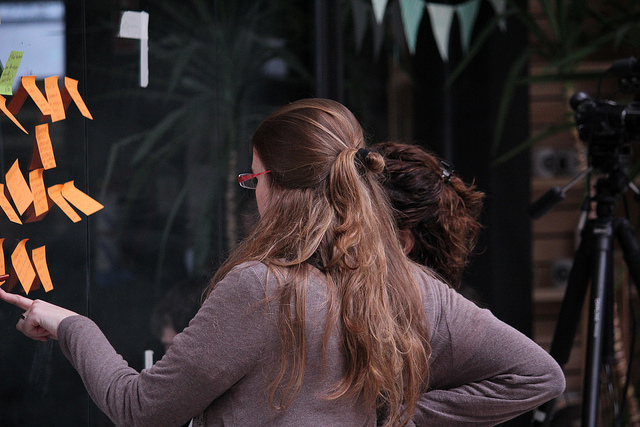Unlock the Magic in Your Story Now
Get the Free 20 questions to Ask Before Launching Your Idea workbook when you sign up for occasional updates.
Get the Free 20 questions to Ask Before Launching Your Idea workbook when you sign up for occasional updates.
Articles filed in: Success
Keeping Score

Kill rivals, don’t collaborate. That’s what “fire-in-the-belly visionaries” do. The recent article in the Financial Review was reporting remarks from a speaker at their innovation summit. In his opinion, Australian businesses are too friendly. If we are to survive, we need to behave more like Amazon and Uber—”hyper-competitive, Darwinian killing machines.”
A reminder of how far astray the way we keep score has led us. Yes, our species survived because we gained physical advantages over our predecessors. But we thrived because of our ability to cooperate within our tribe. We would never have become what we are today if we hadn’t built camps and begun living and collaborating in clans. We evolved as a species to both survive and belong. We succeed when we strive to become better and look out for each other—when we find purpose and meaning without always keeping score.
What kind of world do you want to wake up in tomorrow? Because that’s the world, you’ll create with the intention you set today. You can obsess over your competition or focus on creating the future you want to see.
Image by Zona
More And Better
filed in Success
 We make more friends by being a better friend.
We make more friends by being a better friend.
We do better work by putting more of ourselves into the work.
We find more solutions when we pay better attention.
We ask better questions by doing more listening.
We become more fulfilled when we get better at discerning what matters.
We get better at the big things by doing the small things with more care.
Endeavour is a verb.
Image by carnagenyc
Why Not Make Something Great?
filed in Storytelling, Strategy, Success
 Like his grandfather, before him, Shane was in the textiles business. He made good socks for a living until the day he realised that pretty soon there would be no living to be made in a product that was good enough. His company was struggling to differentiate from and compete with big retailers who could manufacture and sell socks faster and cheaper. Shane realised their survival depended not on competing to make a comparable product only cheaper, but on understanding the customer who would be delighted by and pay more for the warmest socks in the world. Ten years on his business is thriving because he dared to rethink his business model.
Like his grandfather, before him, Shane was in the textiles business. He made good socks for a living until the day he realised that pretty soon there would be no living to be made in a product that was good enough. His company was struggling to differentiate from and compete with big retailers who could manufacture and sell socks faster and cheaper. Shane realised their survival depended not on competing to make a comparable product only cheaper, but on understanding the customer who would be delighted by and pay more for the warmest socks in the world. Ten years on his business is thriving because he dared to rethink his business model.
Without exception, whoever you are and wherever you’re reading this there’s one thing you have in common with every other person who is reading it too. You want your business or idea to succeed. You may not know exactly the path to that success, but you’re clear about the destination you want to reach.
Two things trip us up on the way to making our ideas matter. The first is our love affair with those ideas. The second is the fear of failure. In many cases, we’d rather press on uninformed and unenlightened than face the truth about the changes we may need to make to get to where we want to go. Because we invest so much of ourselves in our projects and businesses, the prospect of failure is painful. So we apply blinkers or look the other way hoping against hope that we were right all along. Blissful ignorance won’t help you to take your ideas from good enough to great.
The single biggest difference between a good product and a great one is the worldview and the posture of the person who created it. Instead of falling in love with their ideas they fall in love with their potential customers and users. They wonder what their customer cares about most. They look for problems to solve and unmet needs to fulfil. They strive to become indispensable by creating products and services that are not just useful, but meaningful. They’re not afraid to get it wrong because they know their missteps take them one step closer to getting it right.
We all have the potential to be that person if only we can lean into the doubts and dig deeper. That’s what I’m inviting you to do today. You can join me and other like-minded peers who are making their ideas matter by registering for The Story Strategy Course which starts on October 2nd. The course is self-paced, but you will have access to the platform and content as soon as you sign up, so you can get a head start. Be the exception. Take your idea from good to great.
Image of Fearless Girl by Shinya Suzuki
We And Us
 The group of colleagues on a business trip say goodbye as they board their respective flights. The boss congratulates them on a job well done. Their smiles slip as soon as he’s out of earshot. How could he possibly think that meeting was a success? The company is just going from bad to worse.
The group of colleagues on a business trip say goodbye as they board their respective flights. The boss congratulates them on a job well done. Their smiles slip as soon as he’s out of earshot. How could he possibly think that meeting was a success? The company is just going from bad to worse.
It’s easy to fall into the trap of complaining about what the collective ‘other’ is failing to see or do.
Why can’t they see the culture is broken?
How can they be so out of touch?
Why don’t they do something to fix the problem?
The truth is in every group endeavour there is no ‘they’ and ‘them’ only ‘we’ and ‘us’. We do our best work when we take ownership of the problems and solutions in equal measure. It’s up to us to create the future we want to see.
Image by Manuel Schmalstieg
What’s On Your Y-Axis?
 The strategy for any project or business and even our days, weeks and months could be plotted on a graph using an x-axis and a y-axis. What every endeavour has in common is time. This is plotted on the horizontal x-axis.
The strategy for any project or business and even our days, weeks and months could be plotted on a graph using an x-axis and a y-axis. What every endeavour has in common is time. This is plotted on the horizontal x-axis.
What we can change or influence is represented on the vertical y-axis. In a commercial world, we tend to measure the thing we are actively working to increase on the y-axis—dollars, revenue and profits, numbers of customers or users. Our y-axis is the place to plot the thing we want more of—something we want to change.
In 2009 Airbnb was struggling to gain traction, with a total weekly revenue of $200. The founders needed to do something to increase revenues dramatically if the business was to survive. They could have focused on getting more listings and more bookings, instead they doubled down on getting to know their hosts better, understanding how they could help them to succeed. They plotted customer success on their y-axis. This deliberate focus on helping hosts was a turning point in the business.
Every day begins with a quest for more. We’re all looking for ways to amplify our reach, grow our influence and increase our impact. It’s never been more important to be intentional about what’s on your y-axis.
Image by Sue Seecof
What Do You Need More Of In Order To Succeed?
filed in Storytelling, Success
 If you had to pick one thing you need more of in order to succeed what would that be? Do you really need more time or more resources? Will more attention or more influence enable you to get to where you want to go?
If you had to pick one thing you need more of in order to succeed what would that be? Do you really need more time or more resources? Will more attention or more influence enable you to get to where you want to go?
When we dig deeper what we find we’re lacking isn’t cash or connections, it’s the courage and commitment to finish what we started. The story we tell ourselves and the lines we draw are a choice. What are you choosing to believe and act on today?
Image by Thomas Hawk
The Work And Reward
 The customer is not there when the flowers he ordered to be delivered on a special birthday are sent too early without his handwritten greeting—which is still paperclipped to the order book. The florist gets on with processing the rush of early morning deliveries. It’s one of those days when she’s just too busy to care about every little detail. What the customer doesn’t know won’t hurt him.
The customer is not there when the flowers he ordered to be delivered on a special birthday are sent too early without his handwritten greeting—which is still paperclipped to the order book. The florist gets on with processing the rush of early morning deliveries. It’s one of those days when she’s just too busy to care about every little detail. What the customer doesn’t know won’t hurt him.
The owner is not at the Italian restaurant on Bourke Street at 6 am when the window cleaner is training his new employee in the art of washing windows. He stands back, arms folded, observing—pointing out a smudge in the top right-hand corner of the big pane of glass. The trainee rubs it away—all the while learning about the standard he must uphold when no one is watching.
It’s a privilege to witness someone taking this much pride in what he does—work that many people might regard as menial or meaningless. It’s as if the work itself is the window cleaner’s reward. This is how we behave on our best days. We don’t make the distinction between what’s seen and unseen. We forget to make the connection between the work and some future payoff—money, attention or accolades. We simply do the best work we can for its own sake—rendering the work, ourselves and the world the better for it.
Image by Davide Gabino
How Could We Have Done Better?
 Whether things go right or wrong, we instinctively understand there’s always room for improvement. And yet, remarkably, we rarely stop to ask ourselves exactly how we could have done better. Instead, we beat ourselves up about our failures—playing the disappointment over and over in our head. Or we self-congratulate without taking the chance to build on our success.
Whether things go right or wrong, we instinctively understand there’s always room for improvement. And yet, remarkably, we rarely stop to ask ourselves exactly how we could have done better. Instead, we beat ourselves up about our failures—playing the disappointment over and over in our head. Or we self-congratulate without taking the chance to build on our success.
Success and failure are opportunities for growth in equal measure. We should make the most of them. Decide what one thing you could you have done better, then go ahead and do it the next time.
Image by Hamza Butt
What’s Your Failure Strategy?
filed in Marketing, Strategy, Success
 Everything runs like clockwork when all staff members show up for the hectic Sunday morning shift at the cafe. Customers are greeted at the door, informed about delays and offered a drink while they wait for a table. The whole system falls apart when one team member calls in sick. Waitstaff double as greeters and coffee runners. People forget to prioritise, service is compromised, and customers get disgruntled.
Everything runs like clockwork when all staff members show up for the hectic Sunday morning shift at the cafe. Customers are greeted at the door, informed about delays and offered a drink while they wait for a table. The whole system falls apart when one team member calls in sick. Waitstaff double as greeters and coffee runners. People forget to prioritise, service is compromised, and customers get disgruntled.
Every business has a success strategy. We set targets and create plans to achieve them. We imagine how we will perform and serve customers on our best days when staff show up on time and everything is going according to plan. It’s much harder to plan for failure. We don’t devote the same time and resources to imagining our next move for those times when we have to deviate from our original plan. We’re unprepared for failure because we don’t always think about what could go wrong and what we will do when it does.
The server might crash.
The package may get lost.
The email might offend.
The salesperson could have a bad day.
The marketing campaign might not perform as you hoped.
What then?
The difference between an exceptional performer and an average one is that they prepare for their ‘off’ days. It turns out that we do our best work when we plan for failure and success in equal measure.
Image by Garry Knight
Noticed Vs. Remembered
filed in Marketing, Strategy, Success
 For every ten things we do today to get noticed we will do one thing worthy of being remembered. The irony, of course, is what we want deep down is to do work that’s remembered—not just noticed. We only achieve that goal by redressing this imbalance—forsaking the desire for attention today, to double down on doing something that will still matter tomorrow.
For every ten things we do today to get noticed we will do one thing worthy of being remembered. The irony, of course, is what we want deep down is to do work that’s remembered—not just noticed. We only achieve that goal by redressing this imbalance—forsaking the desire for attention today, to double down on doing something that will still matter tomorrow.
Image by Ant